Under the regime of Nelson Mandela in the 1990s, South Africa conducted a unique and interesting experiment in the market for private insurance. After deregulation in 1994, virtually every type of health insurance plan sold in the United States was able to enter the South African market – from HMOs to PPOs to Medical Savings Account (MSA) plans. And after a favorable ruling from the tax authorities, employer deposits to MSAs received the same tax treatment as employer payment of third-party insurance premiums.
Thus in South Africa, MSA plans have competed against other forms of insurance on a level playing field. The result has been remarkable. In a few short years, MSA plans have become increasingly popular, and they already have captured about half the market. By contrast, HMO-type managed care has made only small inroads.
In the United States, the design of tax-free MSA plans allowed under a special pilot program is rigidly specified in the tax code. In South Africa, insurers have been free to innovate and experiment. The result is a far more interesting product – one better designed to meet customer needs:
- Whereas a U.S.-type MSA plan has an across-the-board deductible covering all medical services, South African MSA plans typically have varying deductibles.
- For example, a representative plan has no deductible for hospital care on the theory that patients exercise little discretion within hospitals, but a $1,200 deductible for outpatient care on the theory that patients have a lot of discretion in that setting.
- The high deductible also applies to drugs, but for chronic conditions, for which skimping on drugs could lead to more expensive care later, the deductible drops back to zero.
Only 20 percent of South Africa's population has private health insurance. Most of the remainder relies on a public system of free care. But because of rationing and problems of quality in the public sector, the private sector has been growing. This has encouraged insurers to introduce new products and product designs. Among the more interesting MSA product innovations are:
- A wellness program with prizes and bonuses for wellness activities (e.g., health club participation) and preventive measurers (e.g., Pap smears and mammograms).
- An information hotline to assist patients in making decisions.
- A system for electronically verifying MSA balances and third-party liability at the time prescription drugs are purchased.
South Africa's extensive experience with MSAs enables researchers to answer questions about them that have been raised in the United States and elsewhere:
- MSAs definitely save money; the average MSA holder spends about half as much on outpatient services plus drugs as do people in traditional plans.
- There is no evidence that MSA holders skimp on primary care in a way that leads to higher inpatient costs.
- Judged by the incidence of catastrophic claims, MSA holders are not healthier as a group than enrollees in conventional insurance plans.
- Although MSA plans appeal to people who are healthy, those who are sick and have high health care costs are also financially better off in MSA plans than in traditional insurance.
These findings contain important lessons for other countries considering health insurance reform.
[page]For most of the last decade – under the leadership of Nelson Mandela – South Africa enjoyed what was probably the freest market for health insurance anywhere in the world. Although only about one-fifth of South Africans actually buy private insurance, their options have ranged from American-style HMOs and PPOs to Medical Savings Account (MSA) plans.
"Under Nelson Mandela's regime, the popularity of Medical Savings Accounts soared."
Furthermore, South Africa's insurance regulations were and are sufficiently flexible to allow the type of innovation and experimentation that American law stifles. For example, in South Africa there is no law that says HMOs cannot have deductibles. Nor is there a law that says MSA plans have to have minimum or maximum deductibles.
This study addresses one of the most interesting outcomes in South Africa's experience with a free market for health insurance: the emergence and popularity of Medical Savings Accounts.
[page]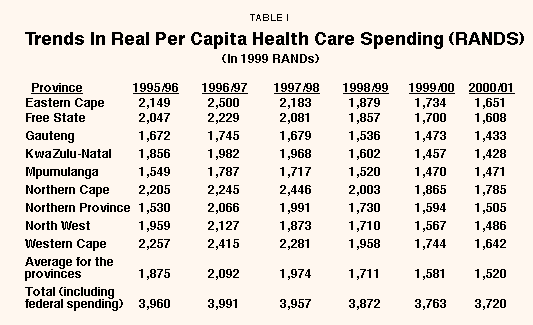
South Africa has an extensive public sector health care system that provides services to approximately 36.5 million people, 80 percent of the population. For participants in this system, health care is virtually free at the point of consumption. Although there is a nominal $3 charge for a physician visit, this fee is almost always waived for those who cannot afford it – and almost everyone who currently uses the system is deemed unable to afford the charge. There is no charge for hospital care.
"About 80 percent of the population relies on free care from the public sector."
Like other health care systems around the world that offer free services, South Africa's public system is plagued by continuing problems of nonprice rationing.1 And like other health care systems in which the pressures of democracy affect the allocation of resources, South Africa's public system has been increasingly sacrificing expensive, curative services for the few who need them in order to expand less expensive, primary care services for the vast majority of people.2
Substituting Care for Cure. In the past, the public system led the world in developing heart transplant techniques. It also developed other cutting-edge medical technologies. At the same time, the provision of primary care services was sometimes sparse and meager, especially in rural areas. With the shift to a more democratic political system, the government has faced pressures to expand primary and secondary care even at the expense of curative services. Per capita health care costs are shown in Table I:
- The table shows a drop (about 1/6 over 6 years) in real per capita spending in the provinces, reflecting an overall reduction in spending to reduce the budget deficit.
- The spending reductions are not spread evenly, reflecting the fact that proportionately more resources are now going to rural areas.
- The relative increase in spending in rural areas represents an increased emphasis on primary care.
The emphasis on universal primary care has been accompanied by a deterioration in the quality and quantity of high-tech medicine the public sector provides. An example is the imposition of moratoriums on certain organ transplants.
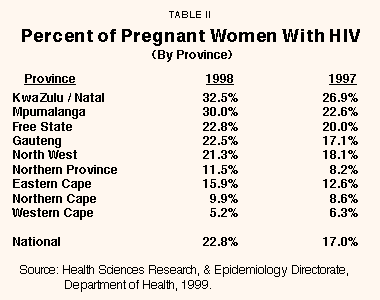
"The public health care system has deteriorated in recent years."
The Consequences of Nonprice Rationing. Wherever medical care is free at the point of consumption, the demand almost always exceeds the supply. The result is nonprice rationing. In South Africa, the rationing problems are even more acute in the hospital sector because resources are being shifted to primary care facilities.
"Overcrowding and staffing shortages are used as a form of nonprice rationing."
Recently a commission of enquiry was established to investigate continuing reports of poor quality health care delivered in the public sector. While the conclusions of the enquiry are not complete, some anecdotes from South African daily newspapers are similar to those from Britain or Canada. For example, according to one description:3
Patients were forced to sleep on the floor and on chairs at Johannesburg Hospital yesterday after staff were unable to accommodate a flood of new admissions. Dr Vivian Fritz, acting chairperson of the medical advisory committee at the hospital, said the medical intake ward had received 71 patients on Thursday. By lunchtime on Friday, staff were still struggling to find beds for 65 of these patients with only five nurses to care for them. They were expecting another 30 to 40 admissions by the evening. Fritz said the trauma unit would "try their best" to cope with any emergency cases, but there would be no specialist care available. The overcrowding came as the hospital announced that staff shortages had forced it to close its reconstructive, orthopaedic and pediatric surgery units this weekend. Twelve community service doctors were transferred from Johannesburg Hospital to Chris Hani Baragwanath Hospital where, Department of Health officials said, the crisis was more urgent.
These circumstances are not atypical or unique. The following are other examples:4
- In July 1999 senior doctors from four of greater Johannesburg's major hospitals warned that a critical staff shortage could force the closure of several emergency units.
- The South African Society of Physiotherapy president, Ms. Anna Bizos, said in June 1999 that Gauteng's principal orthopaedic hospital, the Oliver Tambo Hospital, had one physiotherapist and that many patients lay in bed for days with minimal rehabilitation.
- In July 1999 the head of the trauma unit at Cape Town's Groote Schuur Hospital, Dr Peter Bautz, quit his job because of what he called the "intolerable work conditions in a medical service devastated by budget cuts and spiralling violence."
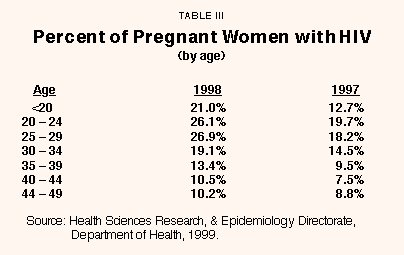
Note that these descriptions are not that different from news reports of similar problems in the public hospital sectors in Britain, Canada and other countries with national health insurance.5
"One in five pregnant women is HIV positive and the public system is overburdened with AIDS cases."
The Problem of AIDS. The problems of poor quality within the public sector are likely to become much worse as the AIDS epidemic worsens. The high volume of AIDS-related hospitalization is putting ever-greater pressure on public sector resources. The prevalence of HIV, as measured by the testing of women in prenatal clinics, is shown in Tables II and III.
- As Table II shows, more than one out of every five pregnant women has tested positive for HIV, and that number is growing.
- As Table III shows, the HIV infection rate is rising for every age level.
How will an already overburdened system deal with the pressures of more AIDS patients? The answer to this question is unclear.
[page]
"About one-fifth of South Africans have private insurance and their number grows about 2 to 3 percent a year."
Partly in response to the problems that plague the public system, South Africa has a large and growing private health care sector. Unlike the public sector, the private sector offers care comparable to that offered by most first-world health care systems. Currently, the 20 percent of the population using the private sector has access to 85 percent of the country's pharmacists and at least 75 percent of all medical specialists.6 As real per capita spending in the public sector has decreased, spending in the private sector is rising dramatically.
Private Health Insurance. In contrast to the public sector, health care delivered in the private sector must be paid for by patients.
- In order to help meet these costs, approximately 20 percent of the population purchases private health insurance in a very competitive insurance market.
- Over the past decade the number of privately insured people has grown about 2 to 3 percent per year. [See Figure I.]
Within the last five years there also has been rapid innovation within the private insurance market, spurred in part by deregulation in 1994. Prior to deregulation, the South African market in many ways resembled the U.S. private insurance market before the advent of managed care.7 That is, it was dominated by nonprofit, bureaucratic organizations that did not function like typical profit-making enterprises.8
Coverage was generally provided at community-rated premiums (without even variation for age differences) and was guaranteed to all applicants regardless of health status. Fees earned by the insurers and/or administrators usually were a percentage of the premium, offering little incentive for cost control or plan innovation.9 The net result was a market dominated by traditional indemnity plans providing first-dollar coverage for most services. With few cost containment incentives in the system, private insurance costs increased dramatically during the 1980s and early 1990s.
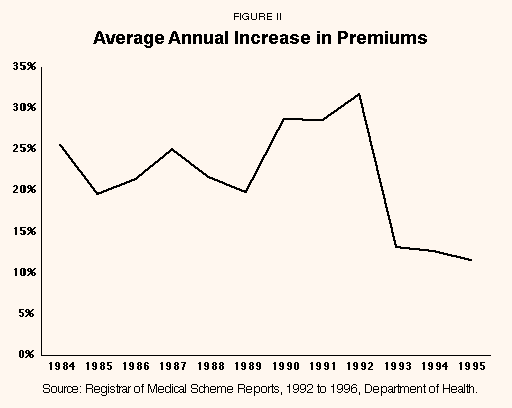
"Competition and innovation reduced premium increases after insurance market deregulation in 1994."
Effects of Deregulation. Deregulation of the market removed a number of constraints on the system, including the requirements of community rating and guaranteed issue. In addition, for-profit insurers were allowed to enter the market. Given the freedom to innovate and experiment, insurers soon began offering a range of health plans: traditional indemnity plans, medical savings account plans, preferred provider plans and HMO-type managed care. Competition and innovation also reduced health insurance premium inflation. (See Figure II.) And it increased the solvency of insurers, as reflected in the growth of assets per enrollee. (See Figure III.)
Companies offering medical savings account products have enjoyed the greatest success. By contrast, U.S.-type managed care plans have not fared well. For example, United Healthcare entered the market aggressively in 1997, in partnership with a local insurance company and a large employer. The venture was unsuccessful. Recently, United Healthcare left the South African market and its operations were absorbed by a large local administrator.
The Threat of Reregulation. Despite the recent success of the market in increasing the number of people insured, reducing premium increases and improving solvency, regulations that became effective this year threaten to derail this progress.
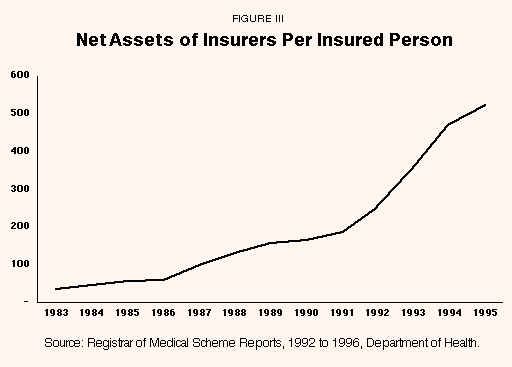
"Despite success, there is the threat of reregulation."
The most troubling new rules are those reintroducing community rating and guaranteed issue (requirements to accept all applicants and charge one uniform premium). Under pure community rating and guaranteed issue, a healthy person would have no incentive to purchase insurance and pay premiums. The reason: The individual could buy insurance at the same premium paid by everyone else after getting sick. In recognition of this problem, the government is allowing insurers to apply preexisting condition exclusions and charge higher premiums to older enrollees. For example, insurers may exclude coverage for certain conditions for enrollees who join a plan after they have developed the condition. Furthermore when people join after age 35, the community-rated premium can be raised by 25 to 75 percent. These provisions encourage people to insure when they are young and healthy.
Many insurers are now designing products for the young and healthy. An example is the Vitality program described below.
[page]
"MSA plans have captured half the market."
As noted above, Medical Savings Account (MSA) plans were introduced into South Africa only after deregulation in 1994. In the brief period since, they have captured about half of the private insurance market. [See Figure IV.] The plans have much in common with the Medical Savings Accounts in the United States, but they also have some important differences.
The U.S. Model: Uniform Deductibles. Medical Savings Accounts were introduced into the U.S. market rather recently, and their benefit design is restrictive. Essentially, MSA plans in the United States consist of traditional insurance with a single deductible across all benefits and a medical savings account to cover expenditures below this deductible.10 Health plans that seek to qualify for tax-free deposits and tax-free build-up in MSAs are required to implement this restrictive design.11
The South African Model: Differential Deductibles. In contrast to the United States, in South Africa insurers may design health plans that best meet their customer's needs. The result is a very different type of plan. The key features of the design of a typical MSA plan are:
- For nondiscretionary services, such as heart bypass operations and other inpatient hospital services, first-dollar coverage is provided.
- For discretionary expenses, such as visits to a general practitioner and other outpatient services, the deductible is about $1,100.
- The plan may also provide first-dollar coverage for medications required to treat such chronic conditions as diabetes, asthma and hypertension.
"MSA plans typically provide first-dollar coverage for inpatient hospital services and a $1,100 deductible for discretionary outpatient services."
The theory behind deductibles that vary with the type of service is straightforward. It makes little sense to ask patients to choose between health care and other uses of money under circumstances in which rational choice is largely impossible. This is typically the case in a hospital setting. On the other hand, most outpatient services are discretionary, and the insured can rationally decide whether a particular medical service is more valuable than any other use of the same money. Prescription drugs for chronic conditions are an exception to the latter rule; first-dollar coverage in such cases benefits both the insurer and the insured.
In general, South African individuals and employers have a great deal of discretion about contributions to MSA accounts:
- Individuals can contribute any amount to their own Medical Savings Account to cover expenses below the deductible.12 While a significant number of people choose an MSA deposit exactly equal to the deductible ($1,100), the average annual MSA contribution is $685.
- Thus, the average monthly contribution for a family is $57 for the MSA in addition to a premium of about $100 for insurance coverage that pays nondiscretionary costs and discretionary costs above the deductible – roughly a one-third, two-thirds division.
- MSA contributions may be made by the individual, an employer or a combination of the two.
Covered and Noncovered Services. The primary purpose of an MSA is to allow individuals direct control of medical expenses that are covered by insurance, but less than the deductible. However, MSAs also allow individuals to pay for health care not traditionally covered by third-party insurance. For example, corrective eye surgery in South Africa costs about $1,500. Since ordinary insurance does not cover the procedure, some people pay for it with MSA money.13
Tax Treatment. In South Africa, health insurance premiums are not tax deductible if paid by an individual unless the individual is over age 65. However, if the insurance is paid by an employer, two-thirds of the contribution is excluded from the employee's taxable income. Similarly, two-thirds of employee contributions to an employer-sponsored plan can be made with pretax money.14
The same rules apply to MSA contributions. That is, two-thirds of any employee MSA deposit can be made with pretax funds and two-thirds of any employer MSA contribution is excluded from the employee's taxable income. Thus MSA deposits and third-party premium payments are treated the same under the tax law.
"The tax treatment of MSA contributions and employer payment of insurance premiums is the same."
Withdrawals. The government's policy toward unused MSA balances has changed over the last few years. Initially, individuals could withdraw unspent MSA balances only after they had withdrawn from a health plan. Unspent MSA funds accumulated in an individual's account, although the account owner could partially offset the accumulation by reducing his or her MSA contributions in future periods. Under this system about 50 percent of
people had a positive MSA balance at the end of each insurance period (a year), and given an annual MSA contribution of $685, the average balance at the end of the year would be about $185.
Under newer regulations, insurers may distribute MSA balances to account holders at the end of every year. Two-thirds of these payouts are taxed as ordinary income.
Spending from MSA Accounts. In South Africa, most insurers negotiate fees for standard services with physicians and other providers. The rates are not binding on individual patients and doctors. If the provider charges the contracted rate the patient can pay directly, or the insurer will pay the fee to the provider. If the provider charges more than the contracted rate, the patient must pay the provider the higher rate and the insurer will reimburse the patient or the patient's MSA at the contract rate. Since providers who charge above the contract rate have to collect the entire bill, thus risking a cash flow and bad debt problem, they have an incentive to stick to the fee schedules.15
Managing Money Flows. A potential problem with an MSA is knowing the exact account balance. In general, at the time a medical service is purchased, both patient and provider want to know what portion of the cost will be paid from the MSA, what portion out of pocket and what portion by third-party insurance. Electronic funds transfers can give patients and providers this information on a timely basis and can allow automatic withdrawals up to the MSA balance – in a manner similar to cash withdrawals from ATM machines.
In South Africa, the insurer Discovery Health has made progress in implementing such a system for pharmaceutical purchases.
"MSA balances and prescription drug coverage can be checked electronically at the time of a drug purchase."
Case Study: Discovery Program for Drug Approval and Payment. At the time a prescription drug is purchased, the customer presents the pharmacist with a Discovery Health membership card. Information from the card is entered into the pharmacy computer along with the drug prescribed or requested. This information is then sent electronically to Discovery Health to determine if the drug is covered and what if any deductible applies. Simultaneously, the system checks the patient's MSA balance. Within 30 seconds the system responds, telling the pharmacist how much the MSA can pay and how much the member must pay out of pocket. Actual payment of Discovery's (the insurer) share of the bill occurs within at least 14 days.
Managed Care. Since many medical services are covered on a first-dollar basis, many health plans use various managed care techniques to control the cost of these services. These techniques include pre-authorization, case management, utilization review and retrospective analysis. The most successful methods of cost control are those that give providers financial incentives to control costs, particularly hospital costs. For example, general surgeons are typically paid on a fee-for-service basis. But under a contract with an insurer, every six months they receive a bonus based on actual generated hospital costs vs. expected costs. Very few HMO-type capitation arrangements exist, and these are largely confined to small communities.
"Diabetics can use their MSA funds to enroll in a diabetic treatment center."
Focused Factories for the Chronically Ill. To improve the management and cost of care for diabetes, Discovery Health has contracted with local centers of excellence to manage the care of diabetic patients in all major metropolitan areas. Under the contract, Discovery Health pays the diabetic center approximately R600 (about $80) per patient per month. In return the diabetic center covers all treatment costs, including medications; consultations with endocrinologists, dieticians, ophthalmologists, podiatrists and other specialists; even hospitalizations resulting from diabetic complications.
The arrangement gives the diabetic center an economic incentive to deliver services efficiently. If the center ensures compliance with the medication and appropriate treatment, fewer diabetics will be hospitalized and the center will be more profitable.
Discovery Health requires that each diabetic patient pay R150 (about $20) of the R600 monthly charge (again, a one-third, two-thirds division). This copayment gives the patient an incentive to fully utilize the program. Discovery Health benefits through lower and more predictable costs. The patient also gets low, predictable costs plus treatment through a center of excellence whose profits are tied to the quality of care it provides.
Because the diabetes program is so new, the data needed to assess it are not yet available. If the program is successful, it can serve as a model for treating such other chronic conditions as asthma.
Lending Programs. Under a typical MSA plan, individuals and their employers make monthly deposits to an MSA account based upon a contribution rate chosen at the beginning of every year. Health plans typically allow members to draw against up to 12 months of MSA deposits at any time during the year.
"MSA plans allow members to borrow up to 12 months of projected deposits for health care claims."
For example, an individual who selects an MSA deposit of R400 ($50) per month can "spend" up to R4,800 (R400 X 12 months; $600) from the account from the beginning of the year. If the individual incurs a claim for, say, R2,000 in February, it will be available to him. But since he or she has, at that point, contributed only R400 to the MSA the insurer must make a "loan" of R1,600 to cover the remaining balance. If the member leaves the plan before repaying the loan, the insurer will make efforts to recover the amount still owed.
In general, members repay their loans from their future MSA contributions. Discovery Health charges interest on loans at a varying rate of approximately 7.5 percent per year, which is roughly equal to the annual rate of consumer price inflation in South Africa. At the same time, all positive balances in the MSA earn 7.5 percent per year interest, payable monthly.
Information Systems. MSAs allow individuals to tailor their health care spending to their specific needs. Individuals require more and more information as medical services become more and more complex. Currently, information is available from various sources, including the Internet. Discovery Health also offers members easy access to clinical information through a toll-free telephone call answered by a nurse who uses a triaging system to give guidance.
Most questions relate to small medical incidents at home. Should the patient self-treat a problem and, if so, how? Or should the patient see a doctor or other health care provider? Depending on the severity of the case, the nurse will either answer these questions using the computer program, forward the call to a doctor or advise the patient to see a doctor.
This technology has also been used to help individuals entering, or considering entering, a hospital. When a patient calls to tell the health plan he or she is entering a hospital for non-emergency treatment, the call can be forwarded to the information hotline.
Bargaining with Providers. The South African medical community is well organized. This is especially true with regard to specialist services, which are in relatively short supply. Their level of organization gives providers a leverage in fee negotiations. To offset this advantage, all insurers negotiate collectively with providers to create the benchmark fee schedules discussed above.
Because the supply of pharmacists is relatively more abundant, insurers have been able to negotiate discounts of up to 20 percent on the cost of drugs. Moreover, since many insurers are slow in paying their bills, individuals paying cash at the point of service can obtain discounts of as much as 30 percent. So even in cases where the insurer is liable, many insurers encourage patients to pay from their MSA accounts and they then reimburse the patient's MSA.
"Patients use their MSA balances to get discounts for cash payment of up to 30 percent, reimbursed later by the insurer."
Incentives to Invest in Personal Health. Discovery Health has an additional program called Vitality, designed to encourage wellness and a healthy life style and costing about 5 percent additional premium. Vitality is a point system: individuals gain points by participating in such wellness-related events as getting mammograms and Pap smears and exercising at a health spa. For example, a mammogram would earn a woman over 45 2,500 points. An improvement in health status also earns points. The points can be used to obtain a variety of benefits. For example, members with no points can purchase round-trip domestic airline tickets on British Airways for 29 percent of the normal fare; members with 60,000 points or more can purchase the same ticket for 8 percent of the normal fare.
[page]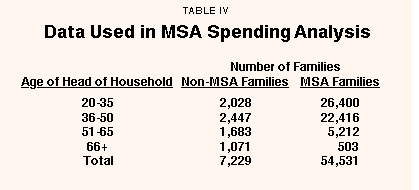
"MSA plans cut discretionary health spending by more than half."
MSAs provide powerful incentives for individuals to contain their health care costs, but some critics have challenged the ability of MSAs to control nationwide costs. Others have argued that if spending is reduced, it may come at the expense of needed medical services.16 To evaluate these and other issues, we constructed two data sets, one for individuals with MSA plans and another for those with traditional plans.17 (Table IV shows the number of families in each group by age in 1997.)
Do MSA Holders Reduce Discretionary (Outpatient) Spending? Consider first the impact of an MSA plan on costs for discretionary, or outpatient, expenditures for people at different ages. As Table V shows:
- Relative to those in non-MSA plans, MSA families reduced their health care spending significantly, ranging from a 56 percent reduction for families in which the head of household is relatively young to a 47 percent reduction for the elderly.
- On average, joining an MSA plan induces people to cut their discretionary spending by more than half.
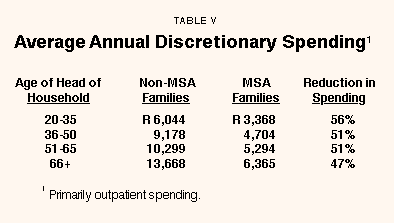
"MSA holders are not healthier, as a group, than people with traditional insurance."
Do MSA Holders Substitute Nondiscretionary for Discretionary Spending? To the degree that cost control is desirable, the above results are quite satisfactory. However, the design of the MSA plan gives enrollees an incentive to seek care in ways that face no deductible rather than in ways that face a high deductible. Put another way, patients have an economic incentive to substitute "nondiscretionary" care for "discretionary" care wherever possible so that the insurer will pay the bill. Thus skeptics may ask whether the savings in Table V are real or are the result of cost shifting. The answer is that management controls can be built into the system to combat these potentially perverse incentives. And as Table VI shows, inpatient spending is lower, not higher, for MSA holders.
Do MSA Holders Forgo Needed Health Care to Save Money? Critics of MSAs sometimes contend that the reduction in spending reflects MSA holders' tendency to forgo appropriate health care. Refuting this criticism would require a randomized longitudinal study with far more clinical data than is currently available. However, a comparison of catastrophic claims under the two different health plans did not show more catastrophic claims under the MSA plan than under the non-MSA plan. Apparently MSA holders are not healthier as a group.
Do MSA Plans Attract Only the Young and Healthy? A common criticism leveled at MSA plans is that they are attractive only to the young and healthy and that they destabilize traditional risk pools. Critics claim this effect is exacerbated by guaranteed issue and community-rating restrictions.
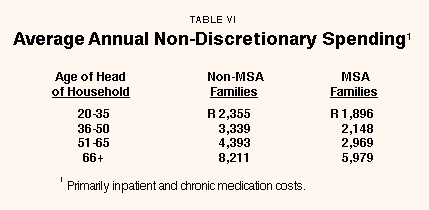
Determining whether this is true required analyzing the data at different levels of outpatient spending to find the benefit received from the plan (MSA savings plus third-party reimbursement) as a percentage of incurred health care costs. The results are shown in Figure V.
"Individuals with high health care costs pay less out of pocket with an MSA plan than with traditional insurance."
For a traditional plan the amount paid by the insurer divided by the total amount spent starts at 80 percent, with a 20 percent copayment required of the insured. As the amount spent increases, various plan limits kick in and the fraction of costs reimbursed deteriorates. Under an MSA plan the pattern is very different.
Low spenders under an MSA plan receive benefits far in excess of their claims due to the savings that accumulate in their MSAs. As the amount they spend increases, their MSA balance decreases. Eventually the MSA is depleted and a self-payment corridor emerges in which no claims are paid by the insurer. Once individuals exceed the annual deductible, the percent of cost paid by the insurer increases dramatically and exceeds the 80 percent level offered by traditional plans.18
As Figure V shows, MSAs are attractive both to the healthy and the sick. The results are clear in the actual data for all age groups.
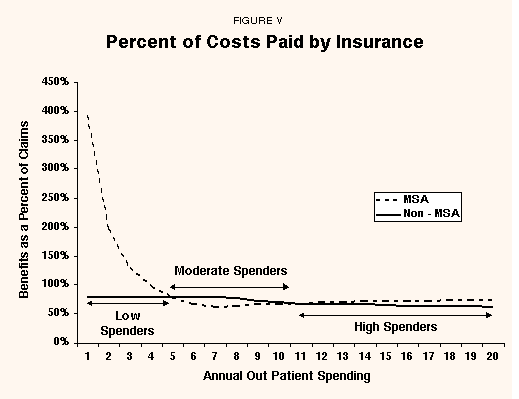
"MSA plan members have lower inpatient costs."
During the 1990s an important and perhaps unique experiment took place in South Africa's market for private health insurance. Deregulation enabled a wide array of health insurance plans to compete in a relatively free market and a favorable tax ruling placed Medical Savings Account plans on a level playing field with third-party-payment insurance.
"MSAs are attracive to all age groups, regardless of health status."
In just five years MSA plans captured half the market, proving that they are popular and meet consumer needs as well as or better than rival products. South Africa's experience with MSAs shows that MSA holders save money, spending less on discretionary items in a way that does not increase the cost of inpatient care. Contrary to allegations by some critics, the South African experience also shows that MSAs attract individuals of all different ages and differing degrees of health.
These findings present important lessons to other countries considering health insurance reform.
NOTE: Nothing written here should be construed as necessarily reflecting the views of the National Center for Policy Analysis or as an attempt to aid or hinder the passage of any bill before Congress.
[page]- For a survey of these problems and their consequences, see John C. Goodman and Gerald L. Musgrave, Twenty Myths about National Health Insurance, National Center for Policy Analysis, Policy Report No. 166, December 1991.
- Ibid., pp. 64-67. For a theoretical explanation of why democracies exhibit these tendencies, see John C. Goodman, National Health Care in Great Britain (Dallas: Fisher Institute, 1980), ch. 6.
- Johannesburg Star, April 28, 1999.
- Source: South Africa Survey 1999/2000 millennium edition, South African Institute of Race Relations.
- Goodman and Musgrave, Twenty Myths about National Health Insurance, pp. 29-31.
- South African Health Review, Health Systems Trust, 1998.
- See John C. Goodman, The Regulations of Medical Care: Is the Price Too High?, (Scan Francisco, California: Cato Institute, 1980), Chapter 5 and John C. Goodman and Gerald L. Musgrave, Patient Power: Solving America's Health Care Crisis, (Washington, D.C.: Cato Institute, 1992), Chapter 5.
- The insurers were mutuals with no shareholders.
- Where for-profit companies did the administration for the mutuals, they earned administrative fees, but they had no financial incentive to be concerned about overall costs.
- John C. Goodman and Merrill Matthews, "Medical Savings Accounts: The Private Sector Already Has Them," National Center for Policy Analysis, Brief Analysis No. 105, April 20, 1994.
- The advantage of a tax-qualified plan is that MSA contributions are treated the same way as the payment of insurance premiums under the tax law: both are paid with pretax dollars. (If the plan is unqualified, MSA deposits are taxed.) However, if unused MSA funds are withdrawn by the account holder at the end of the year, they face income taxes plus a 15 percent penalty (if the account holder is younger than 59 1/2). Funds that remain in MSA accounts grow tax free.
- For example, they may contribute more than the deductible.
- However, since the service is not a "covered benefit," the expense will not count toward the deductible.
- Employers receive a tax deduction on any insurance expense – just as they do for other employee benefits.
- Note also that only the contract rate counts towards the deductible.
- John C. Goodman and Merrill Matthews, "Answering the Critics of Medical Savings Accounts: Part I," National Center for Policy Analysis, Brief Analysis No. 132, September 16, 1994.
- The MSA data set comes from two well-established MSA carriers, Discovery Health and Fedsure Health. The non-MSA data set comes from D & E Healthcare. The data was based on all members present for the full 1997 calendar year. To eliminate potential anomalies caused by different group sizes, the analysis was confined to groups of more than 20 families.
- Assumes a switch from a conventional health plan with a $500 deductible and a 20 percent copayment up to a maximum out-of-pocket limit of $1,500. The net gain is the difference between the MSA end-of-year refund (or out-of-pocket expenses under the MSA plan) and out-of-pocket expenses under conventional insurance.
Shaun Matisonn was admitted as a Fellow of the Faculty of Actuaries, Endinburgh, and a Fellow of the Actuarial Society of South Africa in 1996 and in 1997 as an associate of the Society of Actuaries, USA. He matriculated from Hyde Park High School in 1989 and holds a Bachelor of Science degree in Mathematical Statistics and Actuarial Science from the University of Witwatersrand.
He is currently the Risk Management Actuary at Discovery Health. He has published papers on modeling health care reform and on various health care systems, as well as case studies for the Harvard Business School.